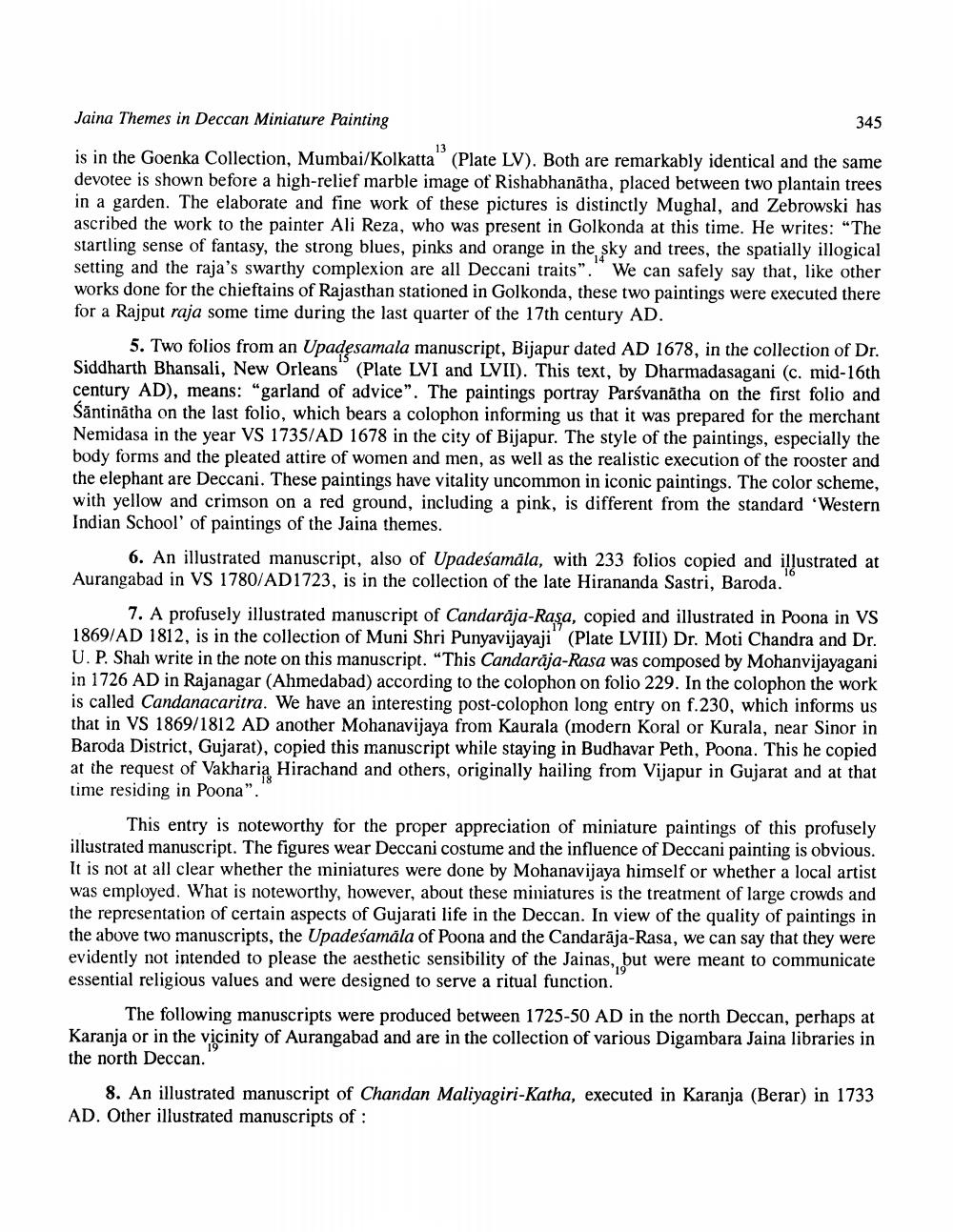________________
Jaina Themes in Deccan Miniature Painting
345
is in the Goenka Collection, Mumbai/Kolkatta (Plate LV). Both are remarkably identical and the same devotee is shown before a high-relief marble image of Rishabhanātha, placed between two plantain trees in a garden. The elaborate and fine work of these pictures is distinctly Mughal, and Zebrowski has ascribed the work to the painter Ali Reza, who was present in Golkonda at this time. He writes: "The startling sense of fantasy, the strong blues, pinks and orange in the sky and trees, the spatially illogical setting and the raja's swarthy complexion are all Deccani traits". "We can safely say that, like other works done for the chieftains of Rajasthan stationed in Golkonda, these two paintings were executed there for a Rajput raja some time during the last quarter of the 17th century AD.
5. Two folios from an Upadesamala manuscript, Bijapur dated AD 1678, in the collection of Dr. Siddharth Bhansali, New Orleans (Plate LVI and LVII). This text, by Dharmadasagani (c. mid-16th century AD), means: "garland of advice". The paintings portray Parávanātha on the first folio and Sāntinātha on the last folio, which bears a colophon informing us that it was prepared for the merchant Nemidasa in the year VS 1735/AD 1678 in the city of Bijapur. The style of the paintings, especially the body forms and the pleated attire of women and men, as well as the realistic execution of the rooster and the elephant are Deccani. These paintings have vitality uncommon in iconic paintings. The color scheme, with yellow and crimson on a red ground, including a pink, is different from the standard 'Western Indian School of paintings of the Jaina themes.
6. An illustrated manuscript, also of Upadeśamāla, with 233 folios copied and illustrated at Aurangabad in VS 1780/AD1723, is in the collection of the late Hirananda Sastri, Baroda.
7. A profusely illustrated manuscript of Candarāja-Raşa, copied and illustrated in Poona in VS 1869/AD 1812, is in the collection of Muni Shri Punyavijayaji" (Plate LVIII) Dr. Moti Chandra and Dr. U.P. Shah write in the note on this manuscript. "This Candarāja-Rasa was composed by Mohanvijayagani in 1726 AD in Rajanagar (Ahmedabad) according to the colophon on folio 229. In the colophon the work is called Candanacaritra. We have an interesting post-colophon long entry on f.230, which informs us that in VS 1869/1812 AD another Mohanavijaya from Kaurala (modern Koral or Kurala, near Sinor in Baroda District, Gujarat), copied this manuscript while staying in Budhavar Peth, Poona. This he copied at the request of Vakharia Hirachand and others, originally hailing from Vijapur in Gujarat and at that time residing in Poona"."
This entry is noteworthy for the proper appreciation of miniature paintings of this profusely illustrated manuscript. The figures wear Deccani costume and the influence of Deccani painting is obvious. It is not at all clear whether the miniatures were done by Mohanavijaya himself or whether a local artist was employed. What is noteworthy, however, about these miniatures is the treatment of large crowds and the representation of certain aspects of Gujarati life in the Deccan. In view of the quality of paintings in the above two manuscripts, the Upadeśamåla of Poona and the Candarāja-Rasa, we can say that they were evidently not intended to please the aesthetic sensibility of the Jainas, but were meant to communicate essential religious values and were designed to serve a ritual function."
The following manuscripts were produced between 1725-50 AD in the north Deccan, perhaps at Karanja or in the vicinity of Aurangabad and are in the collection of various Digambara Jaina libraries in the north Deccan.
8. An illustrated manuscript of Chandan Maliyagiri-Katha, executed in Karanja (Berar) in 1733 AD. Other illustrated manuscripts of:




